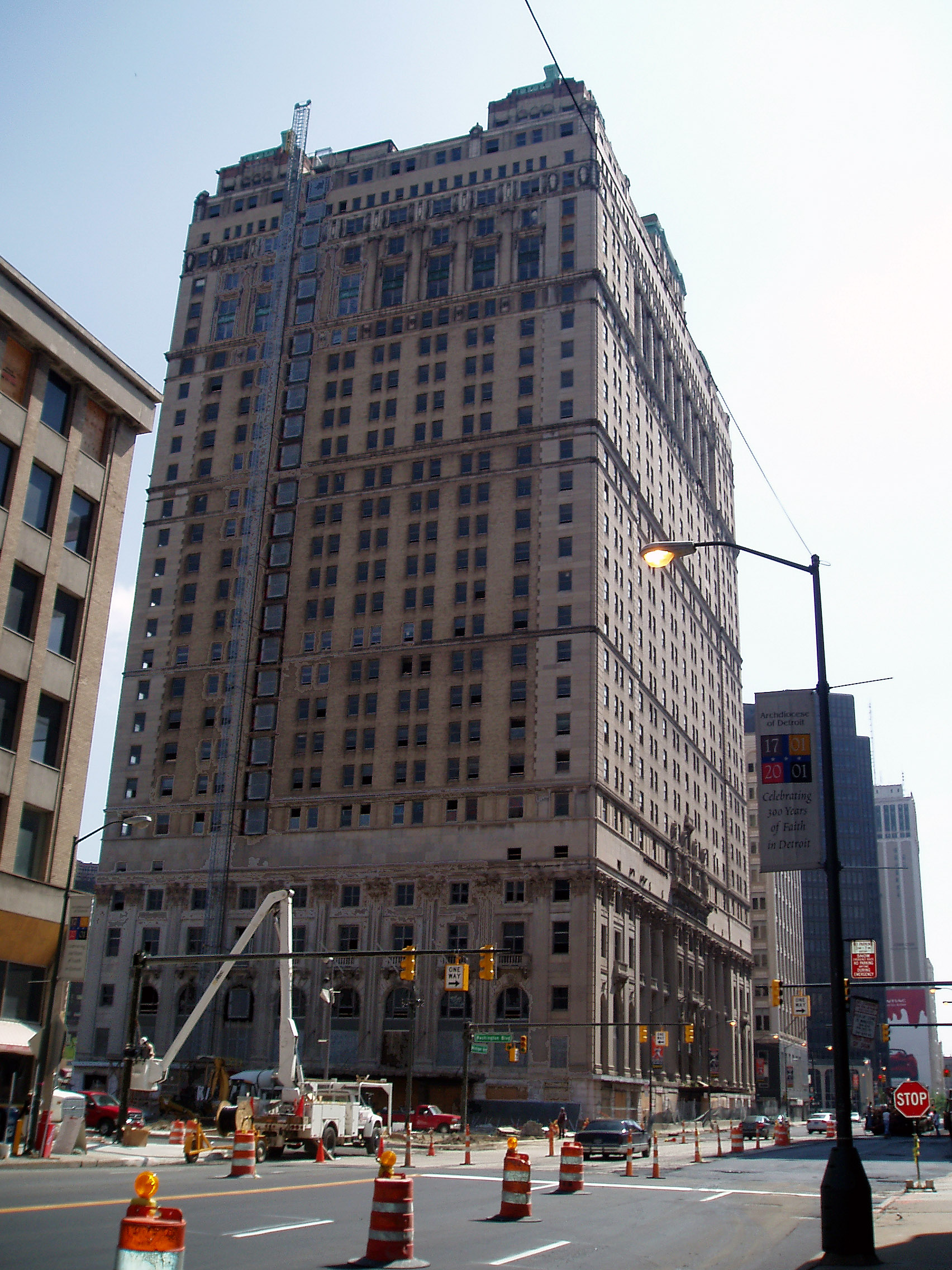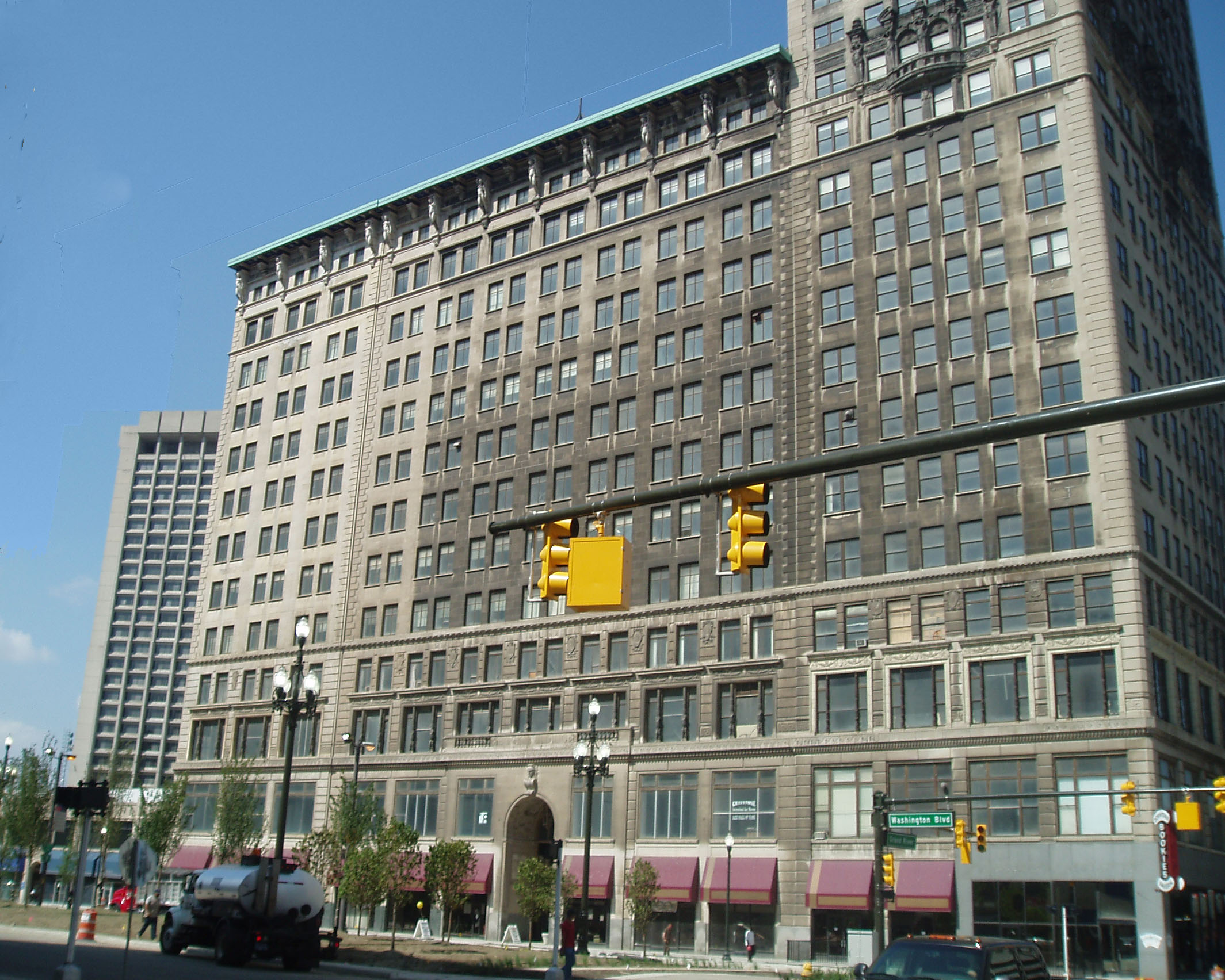
Book-Cadillac Hotel

Book Building

|
Book-Cadillac Hotel |
Book Building |
Book Tower |
|
Judge Augustus Woodward included Washington Boulevard in his 1807 design for the city of Detroit. I believe that early in the 19th century, homes of prosperous Detroiters were built along Washington Boulevard between Michigan and Grand Circus Park. By the end of that century, I think, that the elegant homes were gone and had been replaced by low-rise commercial structures such as those you now find in the several blocks of Monroe that make up the small but distinctive Greektown Historic District.
Phillip Brietmeyer, a florist, was elected to serve as mayor of Detroit in 1909 and 1910. He sought to make the city beautiful, so he capitalized upon the City Beautiful movement that developed after the Columbian Exposition in Chicago in 1892. He appointed a commission, one that included Daniel Burnham, to make recommendation about improving Detroit. One of their major suggestions came to fruition with the development of the Cultural Center that includes Paul Philippe Cret’s Detroit Institute of Art, the Detroit Public Library designed by Minneapolis architect Cass Gilbert and the University of Michigan’s Rackham Building. That committee also suggested that the unattractive low rise building on Washington Boulevard between Michigan and Grand Circus Park be torn down and replaced by structures appropriate for the booming city of Detroit. I believe that city planner Edward Bennett played a major role in this idea and foresaw a nationally recognized boulevard lined with Beaux Arts buildings.
The Book Brothers were one of the most financially successful families in the city in the early 20th century, thanks to their real estate investments and development activities. J. Burgess Book saw a tremendous opportunity in Washington Boulevard. In his mind’s eye, he imagined the development of a commercial shopping district that would rival Madison Avenue in New York. But the buildings along that shopping mecca could also serve as offices for the increasingly prosperous Detroit firms and the professionals who served their needs. The Book family purchased much of the land on Washington Boulevard. Their first investment was the Book Building completed in 1913. Almost immediately thereafter, they began construction of the Book Tower that was finished in 1928. In the meantime, they built the Book-Cadillac Hotel at the corner of Washington and Michigan, an hotel that was among the nation’s largest, most modern and most elegant when it opened in 1924. The Book Brothers also constructed the 29-story Industrial Bank Building at the corner of Washington Boulevard and State. They planned to erect a 70-story office building next to the Book Tower, but the Depression of 1929 terminated those plans. All of the buildings financed by the Book Brothers—the Book Cadillac Hotel, the Book Building, the Book Tower and the Industrial Bank Building—were designed by Louis Kamper The Washington Boulevard intersection with Clifford at Grand Circus Park was anchored by a huge Statler Hotel. That establishment closed in the early 1970s, was decorated for the 1980 Republican National Convention and then razed just before the 2005 Super Bowl.
While there were commercial shops at the street level in most or all of the Book Brothers Buildings, Washington Boulevard did not become a rival to Madison Avenue in New York or Michigan Avenue in Chicago. The Book Brothers lost most or all of their buildings, including the Book Cadillac Hotel by 1931. The empty office buildings were repopulated during World War II, but went into decline after about 1960.
There have been several efforts to revitalize Washington Boulevard in the recent past. In the mid-1967, the large Trolley Plaza apartment building was built on Washington Boulevard near Grand Circus Park. That building got its name from an ingenious but tremendously unsuccessful attempt to restore Washington Boulevard. For a brief period in the later 20th century, historic street cars seemed appealing to downtown developers. Detroit, I believe, bought nine quaint narrow-gauged street cars that had plied the streets of Portuguese cities, seven of them from Lisbon. Detroit officials then laid down track on Washington Boulevard from Grand Circus Park to Cobo Hall in 1976. Four years later, another one-quarter mile of track was laid along Jefferson to reach Hart Plaza. About the same time, planners decided to beautify Washington Boulevard by erecting a lattice work of elevated pipes in the median from Grand Circus Park to Michigan. The intention was to suggest that Washington Boulevard was an attractive, pedestrian-friendly urban mall. I believe that the Rosetti architectural firm designed the system of overhead pipes to be artistic and stimulating, but they were not praised. Indeed, they looked like a strange gigantic tinker toy creation in a rusty red plopped down in the middle of the street.
By 1998, the street cars operated irregularly and carried few passengers. The redevelopment of Washington Boulevard seemed a failure The street cars made their final—just one mile—short trip from Grand Circus Park to Hart Plaza on July 21, 2003. Mayor Kwame Kilpatrick removed the artistic pipes very shortly after taking office in 2004.
I do not know if the Washington Boulevard Historic District includes the Book Cadillac Hotel, or St. Aloysius Church and the Chancery Building, both designed by Donaldson and Meier. I have read some descriptions of this historic district saying that it extends along Washington Boulevard only from Clifford to State, while others say that it extends from Clifford to Michigan. Although the last occupants of the Book Building and the Book Tower moved out in 2009, the Westin Hotel chain began operating a marvelously refurbished Book Cadillac Hotel in October, 2008. The picture of the Book Cadillac shown on this webpage is greatly out of date and misleading.
City of Detroit Designated Historic District: Not listed
State of Michigan Registry of Historic Sites: P25,278
National Register of Historic Sites: Listed July 15, 1982
Description prepared: January 26, 2009
Return to Federal Register of Historic Districts
Return to Michigan Registered Historic Districts